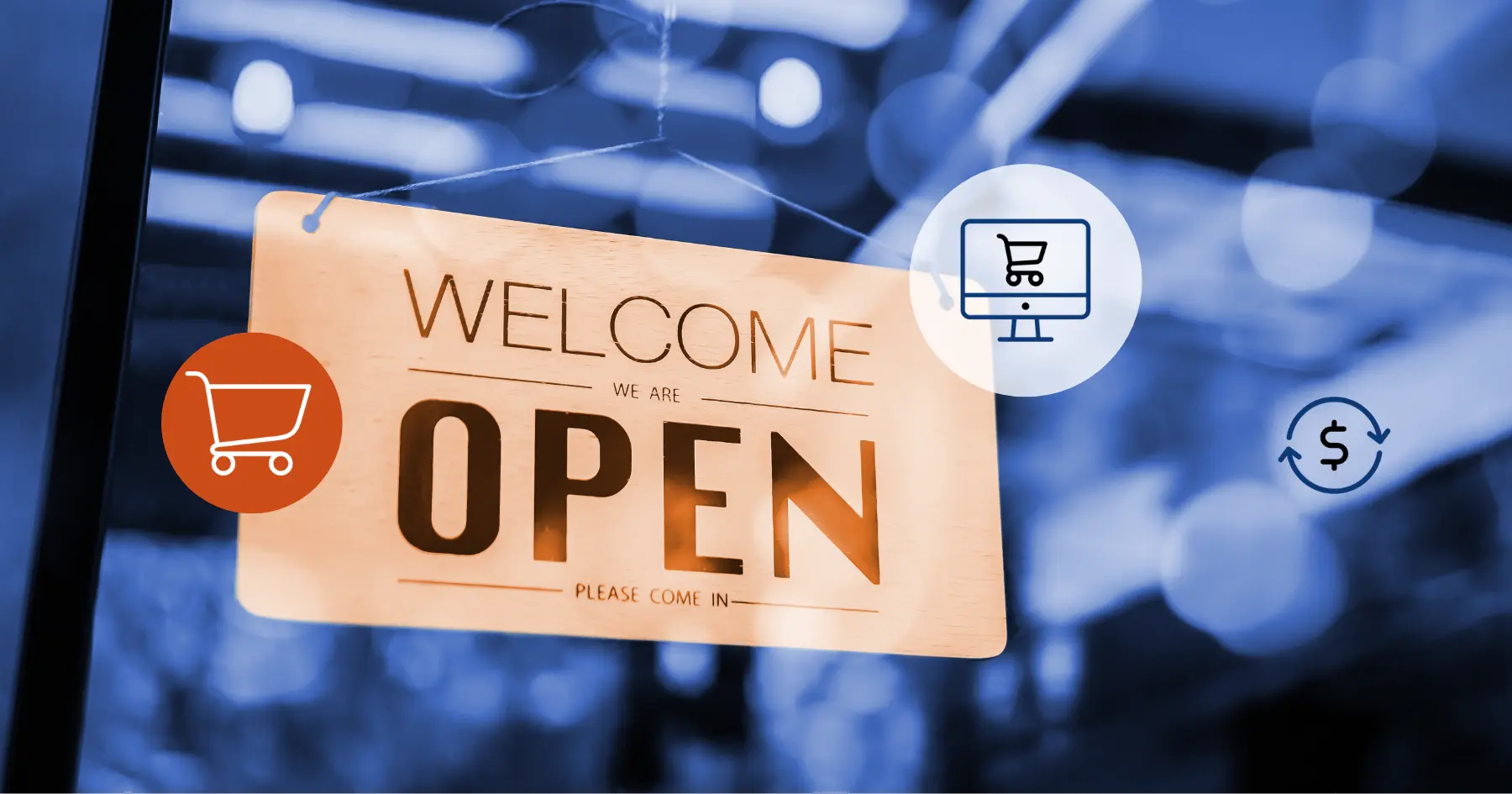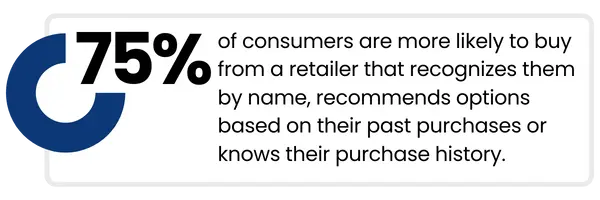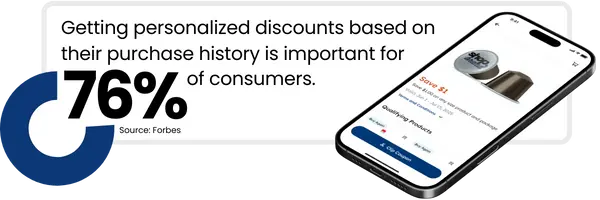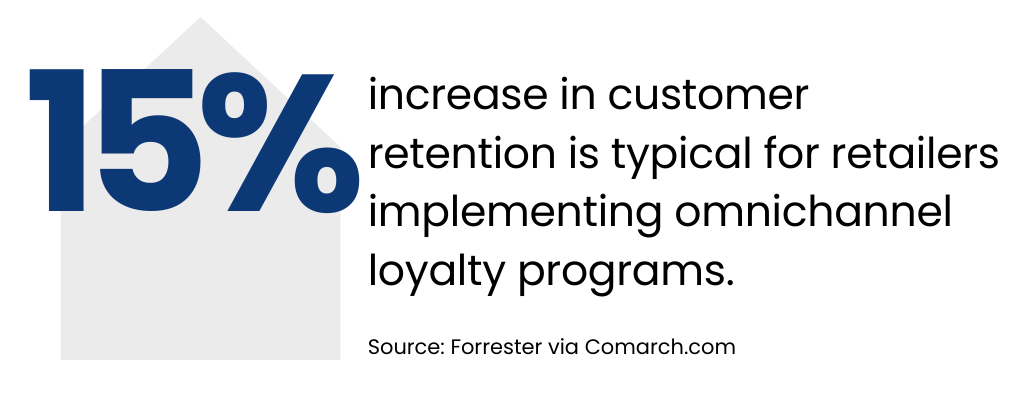
How Independent Grocers Can Build Customer Loyalty Economically and Effectively
If there’s one factor that determines success in eGrocery more than any other, it’s customer retention.
Time and again, we see that great customer engagement leads to an exceptional customer experience, which in turn drives lasting loyalty.
Yet, we also see that as enormous retailers like Walmart capture more of the market, they’re using tools and advantages that smaller grocers can’t easily match. From ultra-low prices to vast marketing budgets and advanced technology, these investments create seamless shopping experiences that consumers are drawn to.
With fewer resources than the big retailers, how can an independent grocer compete to attract and retain loyal customers?
The answer lies in creating a seamless flow of engagement, experience, and retention that builds on the unique strengths of independents. Just as big retailers lean into their advantages to gain market share, independent grocers must identify and amplify their own value propositions.
With strong ties to communities and a reputation for high-touch, in-store service, independents already offer qualities that larger retailers struggle to match. But to truly compete, independents need to bring these strengths into the digital space by pairing them with smart, cost-effective technology.
By doing so, they can deliver a customer experience that resonates deeply, both online and in-store, setting them apart from the retail giants while improving profitability.
This article outlines a four-step approach for an independent grocer to attract, engage, and retain customers through affordable digital strategies. These steps are about understanding capabilities around marketing and customer data and then using technology to boost those capabilities and succeed in a market where customer experience matters more than ever.
Step #1: Understand Your Marketing Capabilities
For independent grocers, creating awareness and attracting new customers begins with integrating a user-friendly eCommerce platform. With that foundation in place, building a comprehensive marketing strategy is essential to promote your digital offerings and drive consistent traffic.
However, this strategy must be built on a complete understanding of your current capabilities.
Effective Marketing Channels
Think about where your store already engages with customers and where you want to expand.
Do you currently have the resources and staff to increase your efforts around the channels listed below?
Website
Is your website up-to-date with engaging content?
Keeping the content on your site and eCommerce platform updated with relevant information is vital to making a great first impression and keeping customers coming back.
Social Media
Are you connecting with your community on social media?
Sharing store updates, showcasing popular and unique products, and engaging with your community through posts will reflect the personality of your store and further engage your followers and customers.
Do you have an email marketing strategy?
Introducing an email marketing campaign will keep customers informed about the newest channels through which they can shop; include special promotions, seasonal products, and other store news.
Effective Marketing Tactics
Beyond these specific channels, you should also consider your tactics for reaching local shoppers who may not yet know about your store’s online options.
Search Engine Optimization
How easily can local customers find your store online?
Optimizing your website and eCommerce platform for local searches can quickly lead to shoppers nearby discovering your digital presence.
Google Business Profile
Are nearby shoppers discovering your store when they search online?
Optimizing and actively managing your Google Business Profile increases your visibility for local shoppers. A fully updated profile—complete with your hours, contact info, and a link to your eCommerce platform—makes it easy for customers to find and shop with you.
Targeted Advertising
Could targeted ads help you reach potential customers?
Using Google Ads or social media ads to reach local shoppers offers independents a way to highlight your digital services—convenient online ordering, exclusive deals, unique products—and capture local interest.
Community-Driven Content
What stories can you share to deepen your community connections?
Creating content that reflects your contribution to the community connects with shoppers who value supporting local companies. This can be done by highlighting local suppliers, featuring customer testimonials, or sharing community event stories
Showcasing Your Store’s Unique Qualities
It’s all about asking yourself two questions:
- What sets your store apart?
- Do I have the ability to communicate these differentiators to potential and current customers?
By highlighting what makes independent stores special—such as local products, community events, or personalized service—you can capture the interest of local customers, introducing them to your digital platform and encouraging them to shop with you.
Step #2: Assess and Strengthen Your Customer Data Capabilities
The next question to consider is how effectively can you collect and unify customer data.
Once initial awareness is established, it’s important that grocers work to deepen the customer relationship by collecting and consolidating data to create a personalized shopping experience.

Larger retailers are able to provide this to their customers through costly and sophisticated data collection methods that most independent grocers can’t match.
However, independents have the advantage of knowing their clientele on a personal level. By leveraging this knowledge and combining it with insights from eCommerce data, independents can speak to individual customer preferences and shopping habits both in-store and online.
This approach allows grocers to build loyalty by showing that they truly understand and cater to individual needs—much like traditional in-store service.
Consolidating Data for a Holistic Customer View
For personalization to be truly effective, however, data from all sources—point-of-sale systems, loyalty programs, eCommerce platforms, and various integrations—should be consolidated into a unified customer profile.
In the past, many grocers have dealt with fragmented data, limiting their ability to see the full customer journey. By integrating these touchpoints, independent grocers can access a comprehensive view of each customer’s behaviors, preferences, and needs.
When this is combined and reinforced with in-store interactions, independents can uncover patterns that may not be visible in isolated data sources. For instance, a customer might shop in-store for fresh produce but prefer purchasing pantry staples online.
Understanding these nuances enables grocers to create a seamless and consistent experience across channels, identifying opportunities for cross-selling or upselling based on the customer’s shopping preferences.
The Importance of First-Party Data
First-party data, gathered directly from customers, is invaluable for crafting these personalized experiences.
This data captures details on customers’ preferences, habits, and purchasing behaviors, enabling grocers to tailor promotions, recommendations, and content with precision.
For example: If a customer frequently buys gluten-free products, the grocer can send personalized offers highlighting gluten-free options, recommend complementary products, and provide exclusive discounts.
This approach is automated and scalable—and best of all—can be affordable; allowing independent grocers to deliver tailored experiences effortlessly across their customer base.
Step #3: Engage Customers Online
Now that you’ve assessed your marketing resources and understand the importance of first-party data collection and consolidation, it’s time to deepen engagement with your customers.
That means reaching each of your customers on a personal level cost-effectively.
Why Engagement Matters
Personalized engagement creates a connection that goes beyond transactions. It’s a way to make every customer feel seen, understood, and valued, fostering loyalty and encouraging repeat visits.
For independent grocers, this engagement is a powerful differentiator. By bringing the warmth of in-store service to the digital experience, you can build the same customer loyalty online that develops in person.
Leveraging Your eCommerce Platform to Deliver Personalized Engagement
An eCommerce platform tailored to your brand is key to making this engagement possible.
It allows you to connect directly with customers using personalized content that reflects their shopping habits and preferences. From tailored product recommendations to exclusive promotions, it all leads to eCommerce interactions.
Here’s how you can use personalization to engage through your platform:
Tailored Product Recommendations
Leverage customer data to suggest products based on past purchases and browsing behavior.
This feature helps customers discover items they’re likely to enjoy, adding value to their shopping experience and increasing their basket size.
Targeted Promotional Offers
Customize discounts and promotions for specific customer segments, like loyal shoppers, new visitors, or those who haven’t shopped in a while.
This targeted approach keeps your promotions relevant and maximizes the impact of each offer.
Automated Marketing Campaigns
Time messages to each customer’s purchasing cycle.
Reminders, seasonal promotions, and product suggestions delivered at the right moment keep customers engaged and drive repeat purchases.

Multi-Channel Delivery
Reach customers wherever they are by coordinating content across email, SMS, mobile push notifications, and social media.
A cohesive multi-channel strategy builds brand recognition and maintains engagement across platforms.
Additional Personalized Content
Use adaptable formats, such as personalized recipes, curated product displays, and exclusive offers, to craft a digital experience that feels one-of-a-kind to each customer.
Fulfilling on the Promise of Personalized Engagement
An effective engagement strategy doesn’t end with a click or even a purchase through your eCommerce platform.
For independent grocers, it’s crucial to have fulfillment options that reflect the needs of their customers and business model. From in-store pickup to convenient delivery solutions, cost-effective fulfillment options allow you to serve customers where and how they prefer.
Independent grocers can meet these expectations by offering flexible, manageable fulfillment services, like:
- In-Store or Curbside Pickup: Offer customers the convenience of collecting orders while saving on delivery costs.
- Delivery Partnership Options: Don’t rely solely on third-party marketplaces that erode profit margin and collect your customer data. Get a choice of last-mile delivery partners that will work best with your goals.
- Flexible Delivery Windows: Provide customers with options that fit their schedules, adding convenience without incurring excessive costs.
High Engagement Without High Cost
By leveraging these personalization tools, independent grocers can create an experience that truly engages. It works because each interaction with the customers feels crafted specifically for them, building loyalty, increasing customer satisfaction, and encouraging repeat visits.
It also aligns with the personal approach these customers receive when they shop in the store. That omnichannel consistency is something that even the biggest tech investment from big retailers can’t reproduce.
And that’s not all.
Personalization is not only more engaging but also more cost-effective than traditional forms of marketing, like weekly circulars.
While circulars require significant investment in design, printing, and distribution, they often miss the mark by targeting a broad audience with limited relevance.
In contrast, personalized digital campaigns allow independent grocers to focus resources on specific customer segments, delivering timely and meaningful offers directly to those most likely to act.
This targeted approach reduces waste and increases the return on marketing spend, making personalization a practical and powerful tool for independents looking to compete in today’s market.
Step #4: Increasing Customer Retention through Loyalty Programs
The final step in building a loyal customer base is developing an impactful loyalty program that goes beyond simple rewards.
Loyalty programs are essential for encouraging repeat purchases and consistent engagement, but traditional programs often fall short of today’s customer expectations.

That’s why effective loyalty programs must provide tailored rewards and valuable experiences, especially given the variety of items customers expect to find in their baskets. Grocers need a program that appeals to shoppers’ multi-occasion needs—whether it’s everyday staples, seasonal items, or special event products.
We’ve already highlighted the importance of unifying customer data to create personalized, targeted engagement. Now, to optimize and scale this level of deep personalization, it’s essential to integrate it into a cohesive loyalty program. This approach involves two critical steps:
Configure Loyalty Management Systems
Implement a robust loyalty management platform that supports seamless program creation, administration, and ongoing optimization.
This system should allow you to tailor rewards, track member activity, and adjust program parameters based on customer feedback and performance metrics, ensuring the program remains relevant and effective.
Develop a Centralized Hub for CRM, Audience Building, and Analytics
Establish a centralized hub where data analytics, customer relationship management (CRM), and audience segmentation tools are integrated.
This hub will allow you to monitor key performance indicators (KPIs) such as customer retention, acquisition, and engagement, giving you a comprehensive view of customer interactions and program performance. By centralizing these functions, you can make informed decisions and strategically plan your loyalty program as it evolves.
Strengthening the Foundation for Customer Loyalty
A loyalty program structured in this way not only enhances customer engagement but also strengthens customer lifetime value.
With each interaction, the program will gather valuable data, feeding back into your personalization and messaging strategies to make them even more effective over time. By aligning a loyalty program with the unique strengths of independent grocers, you can create a cycle of continuous improvement that keeps customers returning, both in-store and online.
This is how independent grocers can build a loyalty program that leans into their community-focused advantages while reinforcing the personalization strategies that set them apart from larger retailers.
This approach doesn’t just increase immediate sales; it develops a long-term relationship with customers, ensuring their ongoing engagement and satisfaction.
Mercatus: The Tech Partner Every Independent Grocer Needs
Independent grocers need more than just a technology provider to cost-effectively develop this type of relationship with their customers. They need a dedicated tech partner who understands their unique challenges and goals.
This is where Mercatus steps in. We’re here to help you strengthen your marketing and data capabilities, enhance customer engagement, and boost loyalty—all without a heavy lift from your staff.
Mercatus offers flexibility to our independent retail partners, with a suite of solutions designed to meet grocers at their current operational capacity and empower them to scale as their strategy evolves.
That means a package designed for grocers who need foundational digital capabilities, delivering a robust eCommerce platform, personalization tools, and fulfillment support—all with minimal lift for your team. For those ready to enhance their capabilities further, our “Independent Plus” package allows grocers to add premium upgrades according to your specific goals and operational strengths.
Mercatus also partners with distributors and wholesalers supporting independent retail banners, providing tailored solutions that streamline operations across multiple stores while respecting the unique needs of each location.
Beyond just providing the technology, we bring expert services that help you maximize the impact of every tool. Our team works alongside yours to ensure smooth implementation and ongoing support, empowering you to compete confidently with larger players—no matter the size of your budget or staff.
To thrive in eGrocery, independent grocers need a partner who understands what it takes to attract, engage, and retain customers cost-effectively. Mercatus delivers the technology and support to make it happen. Reach out to our sales team today to learn how we can help you compete with confidence and capture customer loyalty.
 Newsroom
Newsroom
